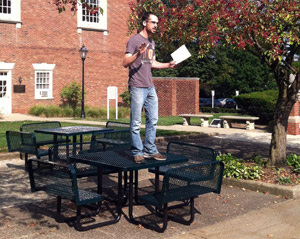 In The Death of Adam, Marilynne Robinson writes, “I do not wish to suggest…that the past was better than the present, simply that whatever in the past happens to be of significance or value ought to be held in memory, insofar as that is possible, so that it can give us guidance.”
In The Death of Adam, Marilynne Robinson writes, “I do not wish to suggest…that the past was better than the present, simply that whatever in the past happens to be of significance or value ought to be held in memory, insofar as that is possible, so that it can give us guidance.”
This quote is the guiding principal for “CH49: American Religious Biography,” a Church history course in which the Rev. Dr. Heather Vacek encourages students to connect the past and present. The course offers an investigation of the history of Christianity in America through the lens of religious biography. Students explore the interactions of theology, context, and Christian practice in the life stories of believers from the colonial era to the twentieth century.
The study of Christianity often focuses on published theologies, institutions, and movements. This course acknowledges that a wide variety of individuals have asserted those theologies and shaped organizations, and have done so from unique social locations. By looking deeply at the accounts of eight American Protestants, students are gaining a deeper understanding of Christianity in America and how beliefs, practices, and context–culture, economics, politics, race, gender—interact.
That exploration takes place in conversation, in writing, via preaching, and even with a bit of role playing. During the term, students read eight biographies highlighting voices (some famous, some not) in Christian history. Then, they summarize these texts in just 140 characters to share on Twitter (#ch49pts). Student Derek Daveport recently tweeted, “Rauschenbusch took scraps from church history and made himself a theological quilt called the Social Gospel.” Additionally, students write blog posts analyzing what they’ve read and offering reflections for their current Christian community. On the blog “Poiesis Theou,” for example, the Rev. Chris Brown ’08, an S.T.M. student, writes about traversing the tightrope walk of Christianity and culture.
“The point of the technology isn’t the technology itself; it’s the ability to formulate a succinct summary of a biographical account that spans 300 pages and Tweet or to think about writing for a real community of faith and blog. In a similar vein, the sermons invite students to bring insight from scripture and history into the present for the sake of the future,” says Vacek.
During the class’s discussion of the colonial era evangelist, George Whitefield, M.Div. student Cassandra Millis guided the afternoon’s investigation of the biography. As part of that exploration, she invited students outside to read portions of Whitefield’s sermons in the Seminary’s courtyard. The eighteenth century evangelist often spoke outdoors to thousands at a time, an astonishing feat.
As their final project, students are asked to select one figure that they’ve studied during the term, and incorporate the significance of his/her account into a sermon based on one of the texts from this year’s All Saint’s Day Revised Common Lectionary readings. Early in the term, Catherine Purves, a student auditing the course, took a similar approach and used a biography of Sarah Osborn, a colonial American, to reflect on the nature of sin and grace. “Page after page of her memoir,” Purves reflects in her sermon, “is filled with laments over how sinful she is. Those things that, in her mind, made her the foremost of sinners included card playing, dancing, and associating with a bad class of people.” Like the apostle Paul, Purves observes, “Sarah Osborn’s sense that she was the foremost of sinners is directly related to her awareness of all that God had done to save her. God had given the utmost, his own Son Jesus, in order to save her, the foremost sinner. The utmost for the foremost. “
Vacek relays, “In this term’s American Religious Biographies class we’ve explored history from the flip side of what many are used to. We’ve traversed the ground of the past alongside the women and men who lived through it. We’ve observed their worlds through their eyes. In addition, we have the advantage of trustworthy guides through that material. The historians who crafted the biographies serve as our guides, as do classmates and professor as we engage each other’s interpretations. There is much wisdom from the past to be gleaned for the present. The communion of saints offer a rich witness!”
